The band pass filter
which used the operational amplifier
|
The band pass filter which used the operational amplifier is composed of the differentiation circuit and the integration circuit. I explain that the differentiation circuit and the integration circuit work first. 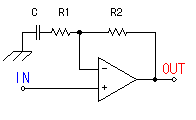 The operational amplifier amplifies and outputs the difference between the input voltage to the positive input terminal and the input voltage to the negative input terminal. The gain when using the operational amplifier which did the negative feedback (NFB) as the inverting gain amplification(It inputs the signal to the negative terminal) becomes G=R2/R1. Also, the gain of the noninverting gain amplification becomes G=1+R2/R1. The following explanation is being explained in the case of the noninverting gain amplification. The operational amplifier amplifies and outputs the difference between the input voltage to the positive input terminal and the input voltage to the negative input terminal. The gain when using the operational amplifier which did the negative feedback (NFB) as the inverting gain amplification(It inputs the signal to the negative terminal) becomes G=R2/R1. Also, the gain of the noninverting gain amplification becomes G=1+R2/R1. The following explanation is being explained in the case of the noninverting gain amplification.When there is not a capacitor (C), that the G duple of the input voltage is done appears in the output. A few states change when connecting R1 and the capacitor (C) in series. 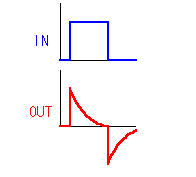 When the input changes into the positive voltage rapidly, in the condition that the electric charge isn't stored up at the capacitor, with the operation of usual operational amplifier, the voltage of doing G duple appears in the output. The electric charge is stored up gradually to the capacitor (C) through R2 and R1 when the output becomes the positive voltage. When the electric charge is stored up at the capacitor, the voltage of the both edges of the capacitor rises and the voltage of the negative input terminal of the operational amplifier rises with it too. The voltage difference between the positive input terminal and the negative input terminal becomes little when the voltage of the negative input terminal rises and the output voltage falls. Finally, the voltage of the negative input terminal becomes equal to the voltage of the positive input terminal and the output voltage becomes 0 V. When the input changes into the positive voltage rapidly, in the condition that the electric charge isn't stored up at the capacitor, with the operation of usual operational amplifier, the voltage of doing G duple appears in the output. The electric charge is stored up gradually to the capacitor (C) through R2 and R1 when the output becomes the positive voltage. When the electric charge is stored up at the capacitor, the voltage of the both edges of the capacitor rises and the voltage of the negative input terminal of the operational amplifier rises with it too. The voltage difference between the positive input terminal and the negative input terminal becomes little when the voltage of the negative input terminal rises and the output voltage falls. Finally, the voltage of the negative input terminal becomes equal to the voltage of the positive input terminal and the output voltage becomes 0 V.This operation is same as the differentiation circuit by the CR. When making the resistance value which is connected with the capacitor in parallel at the integration circuit to mention later the infinity, the output changes straight. However, even if it makes the capacitor and the resistance value to be putting in series 0 ohm at the differentiation circuit, as for the output, there is not a straight change. This is because there is resistance in the input circuit outside. It does the straight change if the resistance value of the input circuit is 0 ohm but it isn't made of the actual circuit. When the alternating voltage signal is inputted, the gain is changed by the frequency.
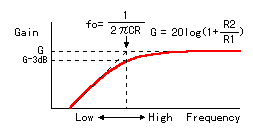 The frequency where the output begins to fall is called the cut-off frequency and it is possible to calculate by the following formula. The frequency where the output begins to fall is called the cut-off frequency and it is possible to calculate by the following formula. When you want to know the reason for falling by 3 dB, refer to "The frequency characteristic of the differentiation circuit and the integration circuit". 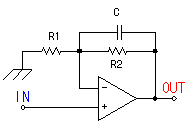 The characteristic of the integration circuit appears when putting R2 and the capacitor (C) in parallel. It becomes the perfect integration circuit when making R2 the infinity and making it only the capacitor (C). 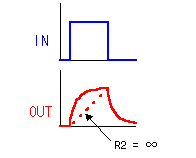 When the input voltage rises rapidly, the output of the operational amplifier tries to rise. When the electric charge isn't stored up at the capacitor, the voltage of the both edges of the capacitor is 0 V. Because it is the same as the voltage of the negative input terminal in this condition, the output is 0 V. The electric current flows into the capacitor with the output of the operational amplifier and the electric charge is stored up gradually. When the charging to the capacitor is done, the voltage of the both edges of the capacitor rises and the output voltage rises. When there is not R2, the electric current which flows into the capacitor is constant and the voltage of the both edges of the capacitor rises straight. When there is R2, this rise isn't straight, in the early stages, it changes fast and in the second half, it pictures the slowly changing curve. When the input voltage rises rapidly, the output of the operational amplifier tries to rise. When the electric charge isn't stored up at the capacitor, the voltage of the both edges of the capacitor is 0 V. Because it is the same as the voltage of the negative input terminal in this condition, the output is 0 V. The electric current flows into the capacitor with the output of the operational amplifier and the electric charge is stored up gradually. When the charging to the capacitor is done, the voltage of the both edges of the capacitor rises and the output voltage rises. When there is not R2, the electric current which flows into the capacitor is constant and the voltage of the both edges of the capacitor rises straight. When there is R2, this rise isn't straight, in the early stages, it changes fast and in the second half, it pictures the slowly changing curve.When the alternating current signal is inputted to the integration circuit like the differentiation circuit, the gain is changed by the frequency.
 The frequency where the output begins to fall is called the cut-off frequency and can be calculated by the following formula. The frequency where the output begins to fall is called the cut-off frequency and can be calculated by the following formula. The gain becomes small as the frequency becomes high at the frequency which is higher than fo. The gain in fo becomes the value which fell by 3 dB from the gain in case of the frequency which is lower than fo sufficiently. When you want to know the reason for falling by 3 dB, refer to "The frequency characteristic of the differentiation circuit and the integration circuit". To have explained above, the differentiation circuit has the characteristic of the highpass filter(HPF) to make pass the high frequency and the integration circuit has the characteristic of the lowpass filter(LPF) to make pass the low frequency. The band pass filter to make pass only the specific frequency band can be composed when combining these two circuits. Of course, it is necessary to be the frequency that the cut-off frequency of LPF is higher than the cut-off frequency of HPF. 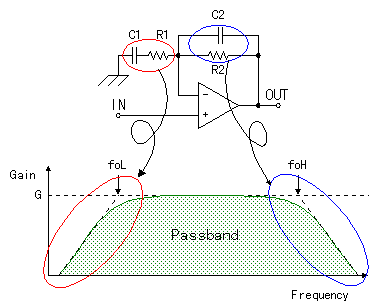 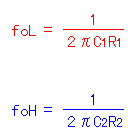 |